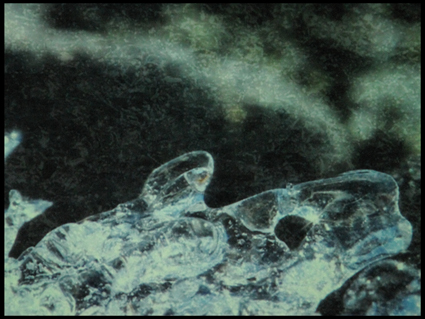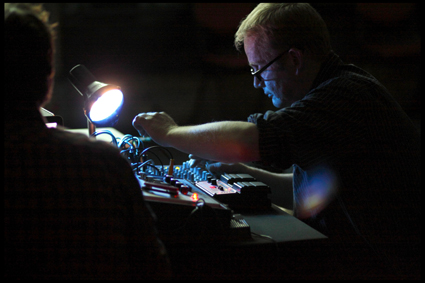antarctic reveries
greg hooper: liquid architecture 13, brisbane

Monolith, Lawrence English, Werner Dafeldecker, Scott Morrison, Liquid Architecture 13
photo Bryan Spencer
Monolith, Lawrence English, Werner Dafeldecker, Scott Morrison, Liquid Architecture 13
AUSTRALIANS HAVE LONG FOUND SOMETHING ATTRACTIVE ABOUT ANTARCTICA—THE LAST FRONTIER FOR THE MANLY VIRTUES OF ENDURANCE IN ISOLATION, A CONTINENT FOR THE TAKING WITHOUT THE INCONVENIENCE OF PRETENDING SOMEONE ELSE GOT THERE FIRST. WHO KNOWS? BUT IT MAKES FOR AN INTRO TO THIS YEAR’S LIQUID ARCHITECTURE: A TIGHTLY CURATED COLLECTION OF WORKS DERIVED FROM THE ARTISTS’ PERSONAL VISITS TO ANTARCTICA.
Except for the first piece by Robin Fox which is a sonification of waverider buoy data from the Southern Ocean, rather than a traveller’s tale. Still, it’s data from about as south as you get before the ocean freezes. The piece starts with the rising and falling of wave heights quantised into discrete steps and then set to a scale. High pitched but not annoyingly so, the sound is metallic and fun. Then a slower, lower pitched version joins, followed by more waves followed by the creaking of ships’ timbers (surely it must be something else, but that’s what it sounds like). More sustained sounds whoosh in, wind and steaming water, but then it gets stupid loud and sensible types in the audience all start shoving fingers in their ears—which would make a nice photo.
Next is a playback piece from an absent Chris Watson. Low creaking rumbles remind me of ocean-going wooden ships again. Sea-beasts sing and fart and splash about then plunge back into the freezing depths. Gulls call out in their usual hysterical and angry panic. A huge something surfaces with a burst of exhalation. Ice drips, waves get trapped against ice sheets, seals surface and drip off by the edge. In some ways these first two pieces show the difficulty in structuring field recordings as composition—there is a sense of sound after sound after sound—which is not necessarily bad, but seems restricted or structurally unexplored.
We’re now sufficiently into the night for me to notice how unusual it is to listen, still, and amongst strangers. People stretch out on the floor in various stages of the sleep-wake cycle. One can almost feel the theta waves resonating out from every resting head, sense the faint click as the thalamus disconnects the body for when the dreams kick in.
The final artist for the night is Doug Quin with what have become the canonical sounds of the Antarctic—Weddell seals calling underwater. The sound is not at all what one associates with large blubbery seals coughing and barking on land. Underwater, the seals sing long gliding chirps and slow descending pitch glides, sparse blurts, grunts, growls and whistles. These are unedited recordings from multiple hydrophones recording simultaneously at depths of 10, 20 and 50 metres—a sort of vertical wall of recording that is laid flat into the room where we are listening. The result is an open, sparse, sound stage with a wide range of volumes and spatial depth to each individual sound—the acoustic in all its complexity leads us into the classic meditative experience of focused attention.
Second night. Philip Samartzis presents a study of “ice behaviour” recorded at the end of summer, when the lakes and the seas begin to freeze. Samartzis produces a wonderfully rich soundscape with superb transitions and modulation of the density and content. Waves well up into the overhangs and cavities along the ice sheet edge; we hear deep plops and resonant squelches, shallow streams and fast bubbling water. And all with a precise, up close clarity until about 20 minutes in when the sound builds to a fast storm, the sound like masses of bees swarming inside an endlessly crashing wave. Back to the (ever) present running water then fade out on reverberant plinks from within a cavern—the first time the acoustic space has obviously changed. Finish with the traditional closing of the laptop—that slightly uncomfortable indeterminate ending of file playback concerts where the dynamics within the piece may include the dynamics of the end of the piece—quiet fades, abrupt silences, who will clap first.
There’s some commonality in the sounds the artists have been using. Makes sense given the environment, but interestingly there’ve been no sounds that are obviously of the voyage or habitation—no sounds of everyone getting up in the morning or making a coffee (hot chocolate and snuggle in for a read before sleep?). Perhaps this is indicative of the overwhelming power of the environment sans human, or perhaps just the efficient call of the exotic—why go to Antarctica to record a kettle boiling?

Monolith, Lawrence English, Werner Dafeldecker (pictured), Scott Morrison, Liquid Architecture 13
photo Bryan Spencer
Monolith, Lawrence English, Werner Dafeldecker (pictured), Scott Morrison, Liquid Architecture 13
Next is the trio of Dafeldeker, English and Morrison with Monolith. Video plus sound. White screen, low pulse from the audio, amazing shot of the regular geometry of a walkway, thin black lines against the snow. Sound continues as regular low frequency bursts, helicopters with high frequencies cut. More lines against the snowscape—isolated human structures looking abandoned, alien, bleached into the snow. The slowly changing imagery, now blurred and offset layers of landscape, is overwhelmingly beautiful—this really deserves large screen cinema. Zoom in to ice as a textured screen, as tessellated light in patterns and transparencies. Then signs of life as fragments of bone bleached and trapped between rocks, bright orange and fluoro yellow lichens. Animal sounds.
Wind rumbles on mics, atmospherics graze across the screen and time scales blur. Snow, smooth and rough, is broken into cliffs, laid out like pillows, coloured like pale oceans and wheat under sun. At times it is hard to tell what we are seeing, the scale and movement difficult to match against experience. Masses of cloud move across the horizon at what must be incredible speed but because of the vastness of the landscape they seem to amble along like a vast and casual herd. The wind picks up, the screen is cut into bands of grey; violent windstorms sound then stop. Floes crackle, ice drips, trickles plop and burble. Thin overlays of surface water, wind blown ripples, soft unbreaking waves. Fade out.
One of the best Liquid Architectures I’ve been to (but do I always think that?) and, with Monolith, an exceptional performance that deserves much greater exposure.
Liquid Architecture 13, Robin Fox, Chris Watson, Douglas Quin, July 4; Philip Samartzis, Monolith trio: Lawrence English, Werner Dafeldecker, Scott Morrison, Brisbane Powerhouse; July 5; www.liquidarchitecture.org.au
RealTime issue #110 Aug-Sept 2012 pg. 18






